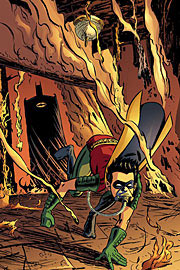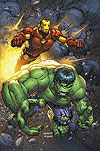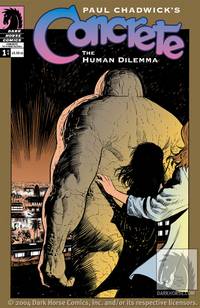I received a royalty check from my publisher today--the first in two years, in fact. Now while most people would be pleased to get a royalty check, I find it to be a bit annoying. Why? The check is for only $11.
You see, the check is for a book I co-wrote back in 1999. While the book sold well for the first couple of years, sales have now dropped off to a trickle. Since I split the royalties with my five other co-authors, there really isn't that much to go around at this point.
Still, I suppose that the publisher has to pay out even small amounts, so as to make the books balance and all. I don't really blame them (they're good people, and I wouldn't hesitate to work with them again).
The annoying part is that for my 2005 taxes, this $11 means that I have to file a whole extra form to declare my whopping eleven dollars in book royalties. (I get a reprieve this time, since they didn't send me a royalty in 2004.)
Of course, I've heard of other writers and artists getting royalty checks for just pennies, so I guess I shouldn't complain too much, right?
Monday, 24 January 2005
Sunday, 23 January 2005
Monkey Covers
Sunday is Monkey Covers day here at YACB. Because there's nothing better than a comic with a monkey on the cover.
From 1981's The Unexpected #210, artists Rich Buckler & Dick Giordano illustrate the feature story "Vampire of the Apes" (script by George Kashdan).
(standard disclaimer about apes not really being monkeys applies)
Image is courtesy of the GCD. Click on the image for a larger version.
From 1981's The Unexpected #210, artists Rich Buckler & Dick Giordano illustrate the feature story "Vampire of the Apes" (script by George Kashdan).
(standard disclaimer about apes not really being monkeys applies)
Image is courtesy of the GCD. Click on the image for a larger version.
Hidden post
If anyone is wondering where my post from earlier this morning is, I've hidden it for the time being, as a cooler head is prevailing now...
After all, it's a Sunday morning, and you were all expecting to see monkeys, not a rant against spam, right?
After all, it's a Sunday morning, and you were all expecting to see monkeys, not a rant against spam, right?
Friday, 21 January 2005
VOYA & BWI
So this is interesting:
Kat Kan writes the "Graphically Speaking" column for VOYA: Voice of Youth Advocates, a magazine for librarians who serve young adults (i.e. teens, to regular folk). In each quarterly column she reviews several (typically four to eight) graphic novels that would be appropriate for a young adult library collection (e.g. in a pulbic library or a high school library). For example, in the December column she reviews Owly, Emily and the Intergalactic Lemonade Stand, Amelia Rules! What Makes You Happy, and The Land of Sokmunster; in the October column she reviewed several manga volumes, including Azumanga Daioh, Blue Inferior, Fruits Basket, and Sgt. Frog.
Okay, that's kind of interesting, but it's no great surprise that libraries are keen on the Graphic Novel these days, and it's only fit that the library review literature is featuring GNs.
The really interesting thing I recently learned is that BWI, one of the leading distributors of children's and young adult books to public libraries, now offers an option for libraries to set up a standing order for all the titles that Kat reviews in her VOYA column.
Standing Order = Guaranteed Sales
We librarians really like standing orders; it's one of those things that makes our work much more managable. I should imagine that soon just about every library that deals with BWI and has a GN collection will sign up for this service (as Kat is generally seen as a very knowledgeable reviewer).
Publishers interesting in submitting their GNs for review by Kat in VOYA should see the information here.
Kat Kan writes the "Graphically Speaking" column for VOYA: Voice of Youth Advocates, a magazine for librarians who serve young adults (i.e. teens, to regular folk). In each quarterly column she reviews several (typically four to eight) graphic novels that would be appropriate for a young adult library collection (e.g. in a pulbic library or a high school library). For example, in the December column she reviews Owly, Emily and the Intergalactic Lemonade Stand, Amelia Rules! What Makes You Happy, and The Land of Sokmunster; in the October column she reviewed several manga volumes, including Azumanga Daioh, Blue Inferior, Fruits Basket, and Sgt. Frog.
Okay, that's kind of interesting, but it's no great surprise that libraries are keen on the Graphic Novel these days, and it's only fit that the library review literature is featuring GNs.
The really interesting thing I recently learned is that BWI, one of the leading distributors of children's and young adult books to public libraries, now offers an option for libraries to set up a standing order for all the titles that Kat reviews in her VOYA column.
Standing Order = Guaranteed Sales
We librarians really like standing orders; it's one of those things that makes our work much more managable. I should imagine that soon just about every library that deals with BWI and has a GN collection will sign up for this service (as Kat is generally seen as a very knowledgeable reviewer).
Publishers interesting in submitting their GNs for review by Kat in VOYA should see the information here.
Thursday, 20 January 2005
Contest Linkblogging
Polite Dissent is giving away three copies of Nikolai Dante: The Romanov Dynasty.
Comic Book Galaxy is giving away Street Angel comics and art.
And remember, Blogity-Blog-Blog-Blog's Colonia Contest ends tonight, so get your entries in now.
And not a contest, but comics.212 has the info about Dave Sim & Jeff Smith Auctions For Tsunami Relief. (Which are already way beyond my price range...)
Comic Book Galaxy is giving away Street Angel comics and art.
And remember, Blogity-Blog-Blog-Blog's Colonia Contest ends tonight, so get your entries in now.
And not a contest, but comics.212 has the info about Dave Sim & Jeff Smith Auctions For Tsunami Relief. (Which are already way beyond my price range...)
Origin Stories
Origin stories are boring.
Okay, that's not entirely true. The Secret Origin story is a staple of comics, and as a kid I remember learning the origin stories of super-heroes that I liked and being totally stoked. The difference is that these were origins for characters I already knew. But starting off with a long, involved origin for a previously unknown character is a sure way to boring the readers.
A perfect example of this is in the first Araña collection from Marvel, which I just read a couple of days ago. It tells the origin of the titular hero, and takes an entire six issues in which to do it. She doesn't even appear in her super-heroine outfit until the final page of the collection.
This is the kiss of death for a monthly serial. The origin is not the interesting story; it's background information. If the information in the origin is important to the story you're telling, then you can go back later and fill in for the reader. But don't start with an issues-long origin.
The original appearance of Superman disposed of the origin story in a couple of panels. It was only later, after Superman became an icon, that his origin was fleshed out (and out and out, ad absurdum).
Or take for example the modern-day classic, Watchmen. Alan Moore created a rich background mythology for the characters, but he starts out the story with the investigation of a murder; in other words, he starts the story at the begining of the actual story; all the background was filled in later, as needed.
But you don't have to be Alan Moore to do this right. Brian K. Vaughan understood this with his recent series Ex Machina (now in an inexpensive trade collection--go buy...) It's the story of a former super-hero who becomes mayor of New York, so the first issue starts with Mayor Hundred in his job. We are slowly being given the origin (both how he became a super-hero and how he became mayor) through flashbacks. Same with Vaughan's Runaways--by the end of the first issue, the kids have learned that their parents are evil super-villains and are on the run.
Super-hero movies are just as guilty as comics. I love the first Superman movie to death, but it takes well over an hour of Krypton and Smallville and the Fortress of Solitude before Chris Reeve dons the familiar red-and-blue tights and takes to flight. The first Spider-Man movie was good, but the second was even better, because the producers didn't have the need to show us the origin again. It took too long for the Green Goliath to appear in the Hulk movie, when let's face it, most people were there to see a big green CGI guy throw tanks around.
The super-hero movie that got it just right was Tim Burton's first Batman. We quickly learn that there's a guy who dresses up like a Bat and roams the city at night, beating up on criminals, and that in the daytime he's Billionare Bruce Wayne. Sure, later on we learn that he became Batman to avenge the deaths of his parents, but even then the movie doesn't dwell on it.
In contrast, the upcoming Batman Begins looks as though it's going to dwell on the Batman origin, which doesn't look too promising. Same with the Fantastic Four movie.
Think of all the good genre movies you've ever seen. How many begin with a long origin sequence? Did Raiders of the Lost Ark start with 45 minutes of young Indiana Jones getting his PhD in archaeology? Did Star Wars begin with the origin of Darth Vader?
Origin stories are not the point; they're background and should be treated as such. It should not take six issues to give us the origin of a character. An interested reader wants to read stories about a teenage girl with spider-powers, not a long drawn-out story about how said girl gets her spider-powers.
Because origin stories are boring.
Okay, that's not entirely true. The Secret Origin story is a staple of comics, and as a kid I remember learning the origin stories of super-heroes that I liked and being totally stoked. The difference is that these were origins for characters I already knew. But starting off with a long, involved origin for a previously unknown character is a sure way to boring the readers.
A perfect example of this is in the first Araña collection from Marvel, which I just read a couple of days ago. It tells the origin of the titular hero, and takes an entire six issues in which to do it. She doesn't even appear in her super-heroine outfit until the final page of the collection.
This is the kiss of death for a monthly serial. The origin is not the interesting story; it's background information. If the information in the origin is important to the story you're telling, then you can go back later and fill in for the reader. But don't start with an issues-long origin.
The original appearance of Superman disposed of the origin story in a couple of panels. It was only later, after Superman became an icon, that his origin was fleshed out (and out and out, ad absurdum).
Or take for example the modern-day classic, Watchmen. Alan Moore created a rich background mythology for the characters, but he starts out the story with the investigation of a murder; in other words, he starts the story at the begining of the actual story; all the background was filled in later, as needed.
But you don't have to be Alan Moore to do this right. Brian K. Vaughan understood this with his recent series Ex Machina (now in an inexpensive trade collection--go buy...) It's the story of a former super-hero who becomes mayor of New York, so the first issue starts with Mayor Hundred in his job. We are slowly being given the origin (both how he became a super-hero and how he became mayor) through flashbacks. Same with Vaughan's Runaways--by the end of the first issue, the kids have learned that their parents are evil super-villains and are on the run.
Super-hero movies are just as guilty as comics. I love the first Superman movie to death, but it takes well over an hour of Krypton and Smallville and the Fortress of Solitude before Chris Reeve dons the familiar red-and-blue tights and takes to flight. The first Spider-Man movie was good, but the second was even better, because the producers didn't have the need to show us the origin again. It took too long for the Green Goliath to appear in the Hulk movie, when let's face it, most people were there to see a big green CGI guy throw tanks around.
The super-hero movie that got it just right was Tim Burton's first Batman. We quickly learn that there's a guy who dresses up like a Bat and roams the city at night, beating up on criminals, and that in the daytime he's Billionare Bruce Wayne. Sure, later on we learn that he became Batman to avenge the deaths of his parents, but even then the movie doesn't dwell on it.
In contrast, the upcoming Batman Begins looks as though it's going to dwell on the Batman origin, which doesn't look too promising. Same with the Fantastic Four movie.
Think of all the good genre movies you've ever seen. How many begin with a long origin sequence? Did Raiders of the Lost Ark start with 45 minutes of young Indiana Jones getting his PhD in archaeology? Did Star Wars begin with the origin of Darth Vader?
Origin stories are not the point; they're background and should be treated as such. It should not take six issues to give us the origin of a character. An interested reader wants to read stories about a teenage girl with spider-powers, not a long drawn-out story about how said girl gets her spider-powers.
Because origin stories are boring.
Wednesday, 19 January 2005
Quick Comic Reviews
 Detective Comics #802
Detective Comics #802by David Lapham, Ramon Bachs & Nathan Massengill
Last issue saw Lapham placing his stamp on the series, giving us an overview of his vision of Gotham as a methaphorically disease infested "City of Crime" and of Batman as the immune agent. While that issue set the foundation and brushed over many stories, this second issue focuses down on one, starting with a harrowing building fire that leads to the discovery of an illegal baby ring. This is Batman as noir, with a detective fighting against a corrupt system that allows the city's sickness to fester, and slowly realizing that the problem may be even deeper than it first appeared. It's not all unrelenting darkness though, as Lapham brings in Robin, who, though named Tim Drake, seems to be more in character with a young Dick Grayson. This final scene, with Batman meeting the mother of a victim he had come to know personally, shows us a Batman who can be dark and brooding yet still human, unlike the asshole Batman that seems to be in vogue in the other Bat-titles. If you like your Batman grim and gritty, Lapham shows the proper way to do it.
Rating: 4 (of 5)
 Marvel Team-Up #4
Marvel Team-Up #4by Robert Kirkman & Scott Kolins
After the enjoyable first three issues, the series heads off the rails with this installment. The cover promises a team-up between Iron Man and The Hulk, but the Green Goliath barely appears, and the 'Iron Man' in question is some sort of alternate-reailty Tony Stark as a Dr. Doom analogue; there's just as much of the Fantastic Four and Dr. Strange in this story as there is of the two top-billed characters. It would be okay if there was a point, but this issue just seems to be filler for the inevitable trade collection. The art by Kolins is just as good as ever though, with its dynamism matching well with the action-packed story.
Rating: 2 (of 5)
 Concrete: The Human Dilema #1
Concrete: The Human Dilema #1by Paul Chadwick
Back in the late 80s, Paul Chadwick's Concrete was one of the first 'independent' (i.e. non-big two) comics I read regularly. The teeneger I was identified well with Concrete's literal alienation and constant introspection, and it was somewhat unique to encounter a comic that contained an element of adventure yet dealt with real-worl concerns. Reading The Human Dilema takes me back to those days, as Chadwick's Concrete has remained pretty much the same. Still focusing on environmental issues, Concrete is approached by a pizza magnate who wants Concrete to be the spokesperson for his radical population control campaign. Meanwhile, his assistant Larry pops the questio to his girlfriend, and while all seems to be well on that front, since this is Larry you just know that it's going to head in a bad direction.
Rating: 3.5 (of 5)
Subscribe to:
Posts (Atom)
